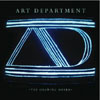Although house music purists might believe otherwise, accessibility is just as important as authenticity when it comes to how tracks are received by audiences. Balancing these two aspects can be incredibly tricky, especially when accessibility is often portrayed by as the betrayal of authenticity — as if it’s impossible to be both broadly likable and true to the aesthetics that inform “real” house. This hasn’t stopped many producers from trying over the past few years, rendering cherished retro motifs with modern production tools for cleaner, more widely palatable sounds. Of those who have attempted combining these values, Canadian duo Art Department have arguably had the most success doing so. Consisting of established talents Kenny Glasgow and Jonny White, the pair’s 2010 debut single, “Without You,” caught many critics off guard when its grassroots popularity catapulted them into the spotlight. Art Department expand on their retro-informed sound with The Drawing Board, an album that appeals to wider audiences even as it reveals the limits of their approach.
The duo makes music in the mold of classic Chicago production duos such as Fingers Inc. and Virgo Four, as well as Frankie Knuckles’ and Steve “Silk” Hurley’s collaborations with Jamie Principle. Glasgow, however, is no Principle. His vocals have a grave, almost eerie quality to them, aligning him more with rock front men than the typical house vocalist. If the duo were concerned about how his long, quivering phrases would be received it doesn’t show on The Drawing Board, as they appear at the center of most tracks. Lean synth lines and uncomplicated percussion often play a supporting role, occasionally mirroring Glasgow’s movements rather than laying out the path in front of him. The combination has the potential to be intoxicatingly catchy: when both elements move in-sync on “Tell Me Why (Part I)” it’s hard not to be hypnotized into repeating Glasgow’s titular request. More often, though, his vocals feel mawkish and ill-fitting without anywhere to hide in the instrumentals. And because he rarely changes his vocal delivery, the album’s most consistent feature leaves it lacking dynamics even as the duo attempts different styles.
There’s no question that focusing on Glasgow’s expressive if gawky voice allows their music stand apart from the work of many Chicago house revivalists. Unfortunately its near ubiquity is part of a broader pattern of missed opportunities that suggest the album is still in draft form and in need of thorough editing. Too often his vocals distract from compelling, well constructed arrangements that could have flourished on their own; in fact, the wholly instrumental “What Does It Sound Like?” is the LP’s finest moment. Yet the two other instrumentals — the shallow trip-hopping “In The Mood” and clumsy dub track “Roberts Cry” — are pointless genre exercises at best. Sometimes Art Department needed only to follow the examples set by their spiritual forebears and end their tracks much sooner. “Much Too Much” and “Vampire Nightclub” do not justify their 10-minute run-times, and trimming the rest of the songs would have yielded stronger and more focused compositions. Often times it seems the duo sorely needed someone to second guess their decisions. Reprising “Tell Me Why” with a new, loopy beat slathered in organ vamps is ill considered. Having Seth Troxler deliver an uninspired monologue throughout “Living The Life” and adlib on “Vampire Nightclub” probably seemed like good ideas at first, but both times he drags down otherwise worthy tracks.
That’s what makes The Drawing Board such a frustrating listen: it’s filled with likable ideas that get trampled by Art Department’s inability to rein in their creative impulses. It becomes fodder for those who view accessibility with suspicion to write off the group rather than dive for its few pleasing pearls. Yet at its core this isn’t an album for the underground despite its creators’ insider status. It courts a sizable audience of outsiders who don’t fuss over authenticity or spend much time keeping up with the relentless pace of new releases. Casual electronic music fans can relate to Glasgow’s shaky, rock-compatible voice and will recognize its broader influences even if they can’t name them. And when it comes time to buy an album, they’re far more likely to gravitate towards The Drawing Board than Steffi’s more faithful Yours & Mine or even Virgo Four’s reissued opus. While Art Department’s fans are hardly wrong for following their tastes, their capacity for enjoying over-long, undercooked house tracks cannot salvage an album that does not deliver on its promise.

















Awesome review. Hits the nail on the head. A lot to like about the album, but it is flawed. The lyrics are really basic. That’s one of the main things that gripes me. I will say that it grew on me a little more after several listens.
Couldn’t agree more, Steve. Was thinking the same thing while listening through the album. There’s some neat ideas, but many of them seem pitched the wrong way.